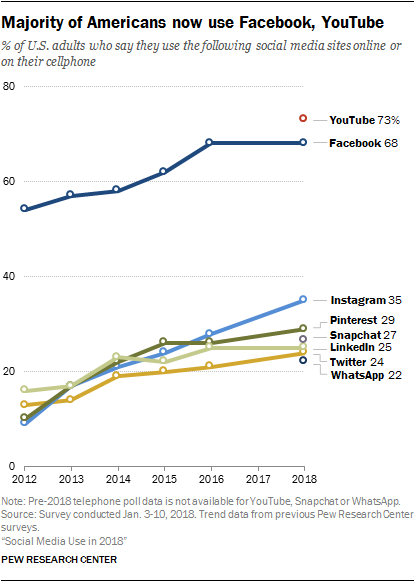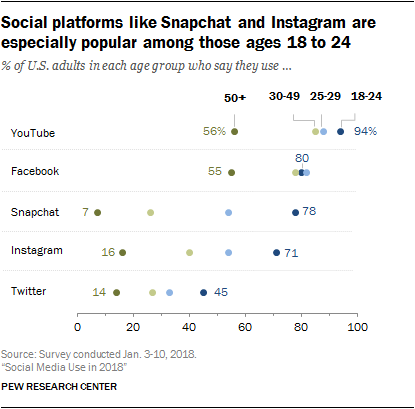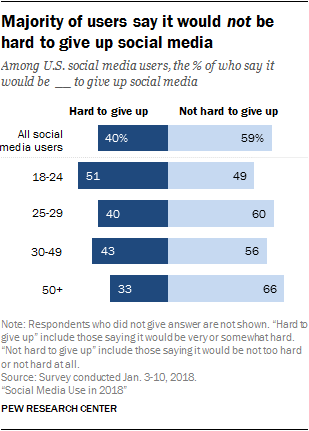Archive of ‘Library and information science’ category
2018 social media use
Social Media Use in 2018
A majority of Americans use Facebook and YouTube, but young adults are especially heavy users of Snapchat and Instagram
http://www.pewinternet.org/2018/03/01/social-media-use-in-2018/
early 2018 is defined by a mix of long-standing trends and newly emerging narratives
Facebook and YouTube dominate this landscape, as notable majorities of U.S. adults use each of these sites. At the same time, younger Americans (especially those ages 18 to 24) stand out for embracing a variety of platforms and using them frequently. Some 78% of 18- to 24-year-olds use Snapchat, and a sizeable majority of these users (71%) visit the platform multiple times per day. Similarly, 71% of Americans in this age group now use Instagram and close to half (45%) are Twitter users

The video-sharing site YouTube – which contains many social elements, even if it is not a traditional social media platform – is now used by nearly three-quarters of U.S. adults and 94% of 18- to 24-year-olds.
a majority of users (59%) say it would not be hard to stop using these sites, including 29% who say it would not be hard at all to give up social media.

- Pinterest remains substantially more popular with women (41% of whom say they use the site) than with men (16%).
- LinkedIn remains especially popular among college graduates and those in high-income households. Some 50% of Americans with a college degree use LinkedIn, compared with just 9% of those with a high school diploma or less.
- The messaging service WhatsApp is popular in Latin America, and this popularity also extends to Latinos in the United States – 49% of Hispanics report that they are WhatsApp users, compared with 14% of whites and 21% of blacks.

+++++++++++++++++++
more on social media use in this IMS blog
https://blog.stcloudstate.edu/ims?s=social+media+use
library role in digital learning innovations
#DLNchat: What Is the Role of Libraries in Digital Learning Innovation?
By Michael Sano Mar 1, 2018
special guest Steven Bell, Associate Librarian at Temple University Libraries
Tuesday, February 27 when the #DLNchatcommunity got together to discuss: What Is the Role of Libraries in Digital Learning Innovation?
“it will definitely be a more sustainable initiative if it is collaborative—-whether it’s OER, open access journals, etc…if the library wants to go alone it will go fast but if it goes with others it will go much further.”
The #DLNchat community concurred there are ample opportunities for library-led collaborations in digital learning across campus. “Curation is key
OER = “Faculty + Librarians + Digital Media Experts = Engaging Content 4 learners.”
considering exactly that-how to create “librarians on demand” to meet students and faculty in dining halls, coffee shops, study lounges or wherever they may be conducting their scholarly work.
++++++++++++++
more on #library and #digital and #innovations in this IMS blog
https://blog.stcloudstate.edu/ims?s=digital+learning+innovations
audio recording and editing
5 Audio Recording Tools Compared – 2018 Chart-13pizlw
vocaroo.com (creates QR code to the recording session)
+++++++++
more on audio recording in this IMS blog
https://blog.stcloudstate.edu/ims?s=audio+recording
https://blog.stcloudstate.edu/ims?s=audio+edit
https://blog.stcloudstate.edu/ims?s=podcast
in anticipation of spring
What's rarer than a blue moon? A snowfall in #Roma. ❄️⛪️ pic.twitter.com/1MwRi3RBnX
— Oliver Astrologo (@oliverastrologo) February 26, 2018
quantum computing
Alibaba puts quantum computing in the public cloud, follows Intel and IBM’s lead
Alibaba has just announced an 11 qubit quantum computer as part of its cloud offerings, making it the second-fastest public quantum computing platform in the world.
Chinese ecommerce giant Alibaba, in partnership with the Chinese Academy of Sciences, has added quantum computing to its cloud service. Alibaba Cloud now hosts a superconducting cloud computer offering 11 quantum bit (qubit) speed, making it the second fastest in the world behind Intel and IBM’s 20-qubit cloud computer.
++++++++++++++++++
https://blog.stcloudstate.edu/ims?s=quantum
assessment learning outcomes
The Misguided Drive to Measure ‘Learning Outcomes’
Privacy data DuckDuckGo
discovery layers
Discovery Layers vs. the Traditional Catalog: e-Forum Summary
http://www.ala.org/alctsnews/features/e-forum-discovery-layers
Erika Johnson and Kristin E. Martin
by discovery layer, the moderators were referring to the variety of tools available to libraries that bring together article-level content, specialized databases, and the content traditionally found inside a library catalog (e.g., books and journal titles) into a single searchable index. Based on the survey, 67% of e-forum participants are using a discovery layer and 83% maintain this layer alongside the traditional catalog. During the e-forum participants identified a number of commercial systems in use at their libraries (Summon, Encore, EDS, WorldCat Discovery, Primo), as well as some customized or open-source products. Participants at some specialized and public libraries expressed opinions that discovery layers do not fit their institutional needs, either because of the lack of sophisticated searching or specialized content, or because of overemphasis on article content.
In academic libraries, discovery layers tend to be the preferred tool for undergraduates, while more advanced scholars (and some library staff) prefer the traditional library catalog for known items, additional search features, and more specialized content. Discussion about the different levels of user sophistication and varying research needs continued through the entire e-forum. One participant put the difference between searching in terms of recall versus precision. Discovery makes an ideal tool for quickly returning at least some relevant results—great for basic research—but often brings back a large number of irrelevant results in a huge set.
From a technical services perspective, discovery layers have led to changes in technical services operations.
Discovery systems are not one size fits all. Special collections librarians and consortial members shared some concerns about the way discovery systems display information.
Good Question! What is a Discovery Layer?
Why is a discovery layer needed for libraries?
Without a discovery layer, users have to search many separate silos of information one by one – the library catalog for books and journals, publisher sites and individual ejournals in particular subjects for articles, and other specialized databases. Even for experienced users who know which databases and resources are likely to be most relevant to their needs, this is time-consuming and involves duplicating the same search over and over in different places. For novice users, or those who want a broad, interdisciplinary search, the initial choice of resource can be daunting and frustrating, unless users already know to ask their librarians for help. In addition, every database or resource interface is different – there are many similarities, but users have to learn different procedures and strategies for each information silo. While specialized interfaces deliver a lot of power for the advanced user, sometimes they can get in the way for other kinds of tasks.
Why not just use Google or another search engine?
Many library resources are difficult to find using search engines, even if a user is savvy enough to be using Google Scholar or Microsoft Academic Search instead of regular Google or Bing. In addition, almost all online library resources, such as full-text articles and ebooks, are most decidedly not free or open access – academic libraries pay quite a bit of money for them
++++++++++++
more on academic libraries in this IMS blog
https://blog.stcloudstate.edu/ims?s=academic+library
create podcast
How to Create a Podcast in Six Minutes or Less
Anchor.fm will distribute your podcast to iTunes, Spotify, Google Play, Stitcher, Overcast, and Pocket Casts.